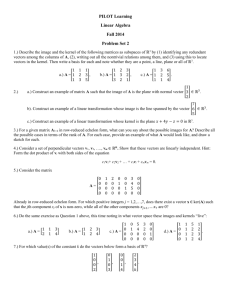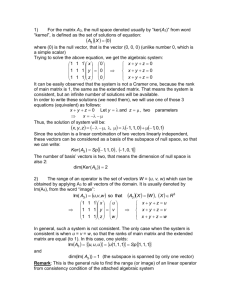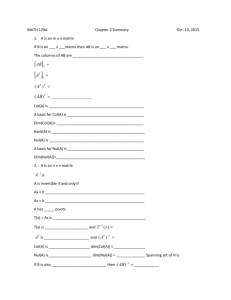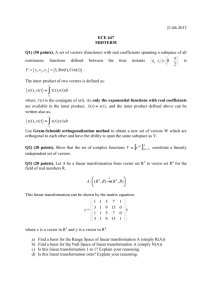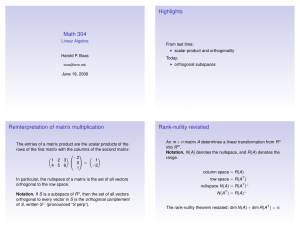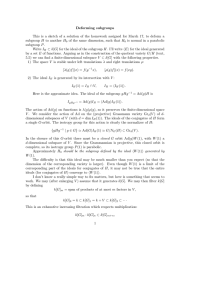18.06.16: The four fundamental subspaces Lecturer: Barwick Monday 14 March 2016
advertisement
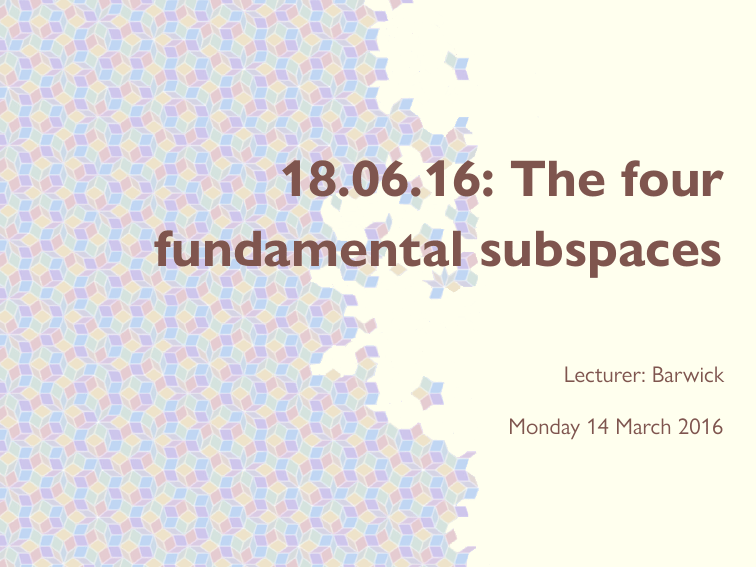
18.06.16: The four
fundamental subspaces
Lecturer: Barwick
Monday 14 March 2016
18.06.16: The four fundamental subspaces
Here it is again:
Theorem (Rank-Nullity Theorem). If 𝐴 is an 𝑚 × 𝑛 matrix, then
dim(ker(𝐴)) + dim(im(𝐴)) = 𝑛.
We saw a proof of this by reducing to rref or rcef, and then checking it there.
There’s just one thing that might bug us here. If I think of the linear map
𝑇𝐴 ∶ R𝑛
R𝑚 ,
then we see that ker(𝐴) is a subspace of the source R𝑛 , but im(𝐴) is a subspace
of the target R𝑚 . So why should these spaces be related?
18.06.16: The four fundamental subspaces
To answer this question, there’s another matrix we can contemplate, the transpose 𝐴⊺ . This is an 𝑛 × 𝑚 matrix, and so it corresponds to a linear map in the
other direction:
𝑇𝐴⊺ ∶ R𝑚
R𝑛 .
This is the map that takes a column vector ~𝑣 and builds the column vector
𝐴⊺~𝑣, but we can perform a trick here. Instead of thinking about transposing
𝐴, we can think about transposing the vectors.
18.06.16: The four fundamental subspaces
So (R𝑚 )∨ will be the set of all 𝑚-dimensional row vectors; equivalently, the set
of all 1 × 𝑚 matrices; equivalently again, the set of all transposes
𝑣 ≔ (~𝑣)⊺
~
of vectors ~𝑣 ∈ R𝑚 . We call (R𝑚 )∨ the dual R𝑚 .
1
0
(
~
So, e.g., if 𝑣 =
−2 ), then 𝑣 = ( 1 0 −2 1 0 ).
~
1
( 0 )
18.06.16: The four fundamental subspaces
The neat thing about row vectors is that they do stuff to column vectors. If
~𝑣 ∈ R𝑛 and 𝑤 ∈ (R𝑛 )∨ , then 𝑤~𝑣 is a number. (Question: How is this related to
~
~
the dot product?)
If 𝑉 ⊆ R𝑛 is a vector subspace, then we define
𝑉 ⟂ ≔ {𝑤 ∈ (R𝑛 )∨ | for any ~𝑣 ∈ 𝑉, 𝑤~𝑣 = 0} ⊆ (R𝑛 )∨ .
~
~
Dually, if 𝑊 ⊆ (R𝑛 )∨ is a vector subspace, then we define
𝑊 ⟂ ≔ {~𝑣 ∈ R𝑛 | for any 𝑤 ∈ 𝑊, 𝑤~𝑣 = 0} ⊆ R𝑛 .
~
~
Fact: dim(𝑉) = 𝑛 − dim(𝑉 ⟂ ), and dim(𝑊) = 𝑛 − dim(𝑊 ⟂ ). (Why?)
18.06.16: The four fundamental subspaces
Now, since
(𝐴⊺~𝑣)⊺ = (~𝑣)⊺ 𝐴 = 𝑣𝐴,
~
we can leave 𝐴 just as it is, and we can consider the linear map
𝑇𝐴∨ ∶ (R𝑚 )∨
(R𝑛 )∨
given by the formula
𝑇𝐴∨ (𝑣) ≔ 𝑣𝐴.
~
~
18.06.16: The four fundamental subspaces
So when we contemplate the kernel and image of 𝐴⊺ , we can think about it
via the map 𝑇𝐴∨ .
For example, ker(𝐴⊺ ) is the set of all vectors 𝑣 ∈ (R𝑛 )∨ such that 𝑣𝐴 = 0. This
~
~
~
space is also called the cokernel or the left kernel of 𝐴. I write coker(𝐴).
We also have the image of 𝐴⊺ , which is the set of all row vectors 𝑤 ∈ (R𝑛 )∨
~
such that there exists a row vector 𝑣 ∈ (R𝑚 )∨ for which 𝑤 = 𝑣𝐴. This space is
~
~ ~
also called the coimage of 𝐴, or, since its the span of the columns of 𝐴⊺ , which
is the span of the rows of 𝐴, it is also called the row space of 𝐴. I write coim(𝐴).
18.06.16: The four fundamental subspaces
In all, we have four vector spaces that are what Strang call the fundamental
subspaces attached to 𝐴:
ker(𝐴),
im(𝐴),
coker(𝐴) ≔ ker(𝐴⊺ ),
coim(𝐴) ≔ im(𝐴⊺ ).
18.06.16: The four fundamental subspaces
Here’s the abstract statement of the Rank-Nullity Theorem:
(1) ker(𝐴) = coim(𝐴)⟂ , so that
dim(ker(𝐴)) = 𝑛 − dim(coim(𝐴)).
(2) im(𝐴) = coker(𝐴)⟂ , so that
dim(im(𝐴)) = 𝑚 − dim(coker(𝐴)).
(3) 𝐴 provides a bijection coim(𝐴) ≅ im(𝐴), so that
dim(coim(𝐴)) = dim(im(𝐴)).
